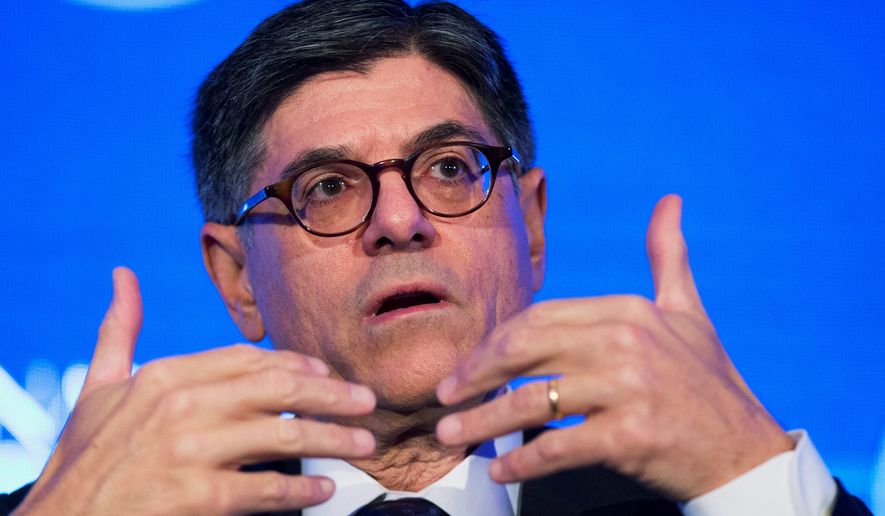Social Security beneficiaries and federal retirees won’t see any raise in their checks next year after a still-sluggish economy sapped inflation in 2015, the government announced Thursday as it reported the smallest deficit of President Obama’s time in office.
The government ended up $439 billion in the red for fiscal year 2015, the Treasury Department reported, as it set new records for spending at $3.688 trillion, but saw tax revenues surge even more quickly.
Still, even though the red ink is spreading more slowly, it’s still accumulating in ever-deeper debt, and Treasury Secretary Jack Lew warned Congress in a new letter that the government will run out of borrowing room on Nov. 2, forcing yet another deadline showdown on a Capitol Hill that is already overwhelmed with political fights.
The Social Security payments freeze will have the most immediate impact on the largest group of Americans. The government reported that since the price index used to calculate inflation actually dropped last year, the law says there’s no need for a cost-of-living raise because the average senior’s expenses didn’t go up.
It’s just the third time in the last four decades that inflation was too low to earn seniors a raise, and seniors advocacy groups said it will be particularly difficult to swallow because a large number of elderly will still have to pay more in premiums and deductibles for Medicare, the government’s medical insurance for the elderly.
Advocates said Congress should change the formula to make sure the elderly and federal retirees, whose pension payments are also tied to inflation, get more money. Some groups also pleaded with Congress and the White House to find a way to inject more money this year.
SEE ALSO: Federal spending soars in 2015; taxes rise faster
“This is unacceptable,” said J. David Cox Sr., president of the American Federation of Government Employees.
But federal finances, while improving, are still tight, making the prospect of a quick infusion unlikely.
Indeed, Republicans on Capitol Hill are looking at bigger spending cuts as they prepare for a showdown over raising the federal debt ceiling.
Mr. Lew had previously said the government wouldn’t run out of maneuvering room until later in November, but in a letter to Congress Thursday he said spending has been running a little higher in recent weeks than he’d predicted, which has moved up the deadline.
He also made clear the administration will blame lawmakers for any problems should Congress refuse to give him more borrowing space.
“The creditworthiness of the United States is an essential component of our strength as a nation. Protecting that strength is the sole responsibility of Congress, because only Congress can extend the nation’s borrowing authority,” he said.
Without a debt increase the Obama administration would face a stark choice: default on debt payments or else suspend more than 10 percent of other usual government spending. The Obama administration says there’s no precedent for how to make that choice.
Total federal debt stands at about $18.2 trillion and has been frozen there since March, when the last debt holiday expired and Mr. Lew had to begin using extra borrowing tools to avoid going over the limit.
Nearly $8 trillion of debt has been added to the government’s tally sheet since President Obama took office in 2009 — by far the largest increase of any administration.
Of the total debt, some $5.1 trillion is the government borrowing from itself — and particularly from the Social Security trust funds. But the other $13 trillion is debt held by public lenders.
Debt is the total accumulation of how much the government owes to creditors. Deficits are the annual tally of spending subtracted from tax revenue.
Even though the debt total is high, the rate of increase in the debt has been slowing as deficits have dropped.
Indeed, the 2015 deficit was about $44 billion lower than 2014’s total, and is down dramatically from the repeated trillion-dollar-plus deficits Mr. Obama notched in his first four years in office.
Mr. Obama’s top economic policy advisers took a victory lap over the numbers.
“President Obama’s agenda continues to put federal finances on a sustainable footing while laying the foundation for durable economic growth and broadly shared prosperity,” Mr. Lew said. “Under the president’s leadership the deficit has been cut by roughly three-quarters as a share of the economy since 2009 — the fastest sustained deficit reduction since just after World War II.”
But budget analysts say the relief is short-lived, and deficits will roar back by the end of this decade. And debt is still accumulating, reaching levels not seen since the end of World War II, when the government paid down the massive tab from fighting the Axis powers.
Most of the improvement is due to the economy, which has finally recovered enough from the Wall Street collapse seven years ago, sending revenue to a record $3.249 trillion. Individual income taxes spiked nearly $150 billion last year to reach $1.5 trillion, while corporate income taxes were up $20 billion to reach $344 billion.
More worrisome, however, is that spending — which had actually dropped in 2012 and 2013, and held relatively low in 2014 — came roaring back in 2015, spiking to 5 percent.
The biggest jump came in health care spending, as Obamacare continued to kick in, sending the Health and Human Services budget careening past the $1 trillion mark. Social Security accounted for $944 billion, up nearly $40 billion in one year.
But Defense Department spending dropped yet again, falling $15 billion to $562 billion — a level not seen since 2007.
• Stephen Dinan can be reached at sdinan@washingtontimes.com.




Please read our comment policy before commenting.